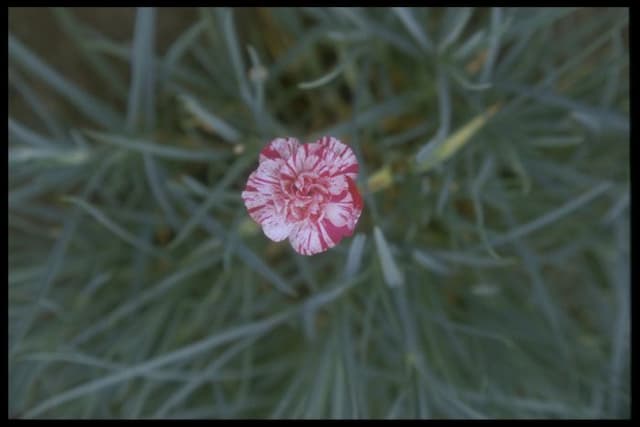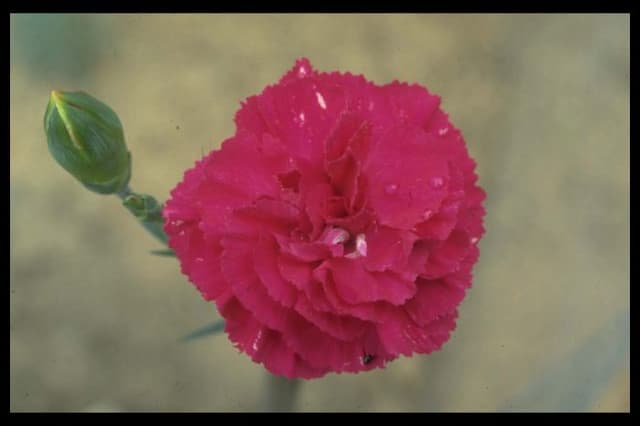Pink Kisses Dianthus 'Rose Joy' (p)

ABOUT
Dianthus 'Rose Joy,' commonly known as Pinks, is an enchanting plant that features a beautiful display of deeply fringed petals that feel almost feather-like to the touch. The flowers bloom in a vivid shade of pink that adds a vibrant splash of color to any garden. They exude a delightful fragrance that is both sweet and spicy, which can often attract butterflies and other pollinators. The foliage of the Pinks is also notable, being a blue-green hue that forms a lovely, neat mound. This foliage creates a striking contrast with the bright flowers, making them stand out even more. The leaves are slender, with a linear shape, and have a somewhat grassy appearance. In full bloom, Pinks create a thick carpet of color due to their clustered growth habit, which can be especially picturesque in rock gardens, borders, or as a part of a floral display in containers. Their enduring charm and color make them a favorite among gardeners looking to add a touch of romanticism to their outdoor spaces.
About this plant
 Names
NamesFamily
Caryophyllaceae.
Synonyms
Pinks, Cheddar Pinks, Clove Pinks, Gillyflower.
Common names
Dianthus 'Rose Joy'
 Toxicity
ToxicityTo humans
Carnations, including the Dianthus 'Rose Joy', are generally not considered toxic to humans. However, some people may have skin sensitivities or allergic reactions upon handling them. Ingesting parts of the plant is not advisable, but typically it does not lead to serious poisoning. Symptoms, if any occur from ingestion, might include mild gastrointestinal upset such as nausea or diarrhea.
To pets
Carnations, such as the Dianthus 'Rose Joy', are considered to be mildly toxic to pets, including dogs and cats. Ingestion of the plant can cause mild gastrointestinal symptoms which may include vomiting, diarrhea, or drooling. Generally, the symptoms are not severe, and typically serious complications are rare. However, pet owners should still prevent their animals from ingesting carnations and monitor them for any signs of illness if ingestion occurs.
 Characteristics
CharacteristicsLife cycle
Perennials
Foliage type
Evergreen
Color of leaves
Blue-green
Flower color
Pink
Height
1 foot (30 cm)
Spread
1 foot (30 cm)
Plant type
Herb
Hardiness zones
3-9
Native area
Europe
Benefits
 General Benefits
General Benefits- Attracts Pollinators: Dianthus 'Rose Joy' attracts beneficial insects such as bees and butterflies, which help in pollinating the garden.
- Aesthetic Appeal: This plant's vibrant pink flowers and distinctive clove fragrance add beauty and a pleasant scent to gardens and landscapes.
- Drought Tolerance: Once established, it exhibits some drought resistance, making it suitable for gardens in drier climates.
- Low Maintenance: Dianthus 'Rose Joy' requires minimal upkeep, making it an excellent choice for busy or novice gardeners.
- Long Blooming: This variety has a long flowering season, providing extended visual interest throughout the growing months.
- Compact Growth: Its compact and clumping growth habit makes it ideal for borders, containers, or small garden spaces.
- Cold Hardy: The plant is relatively cold hardy, which means it can survive in cooler temperatures and frost-prone areas.
- Versatility: Suitable for use in rock gardens, as ground cover, and for edging paths or walkways.
- Deer Resistance: Dianthus 'Rose Joy' is generally resistant to deer, which helps to prevent damage to the plant in areas where deer are a problem.
 Medical Properties
Medical PropertiesThis plant is not used for medical purposes.
 Air-purifying Qualities
Air-purifying QualitiesThis plant is not specifically known for air purifying qualities.
 Other Uses
Other Uses- Culinary Garnish: The edible flowers of the Dianthus can be used to add a splash of color and a subtle spicy flavor to salads, desserts, and cold drinks.
- Natural Fabric Dye: Petals of Dianthus can be boiled to extract their color for use in naturally dying fabrics or yarns.
- Plant Markers: Dried stems of Dianthus can be used as natural, biodegradable markers for garden rows or to label other plants.
- Aromatherapy: Dianthus flowers have a pleasant fragrance that can be used in potpourris or sachets to scent drawers and wardrobes.
- Photography Prop: Due to their beauty and variety of colors, Dianthus flowers can be an excellent subject or backdrop in floral photography.
- Crafting: Dried Dianthus flowers can be used in handmade paper making or pressed flower art.
- Perfume Industry: The scent of Dianthus petals can be included in the making of perfumes, offering a delicate floral note.
- Candle Making: Petals can be incorporated into homemade candles for decoration and to impart a subtle fragrance when burned.
- Bookmarks: Dried Dianthus flowers can be laminated into bookmarks, making a unique and botanical-themed tool for readers.
- Insect Repellent: Some species of Dianthus are believed to possess natural insect-repellent properties and can be planted in gardens to deter pests.
Interesting Facts
 Feng Shui
Feng ShuiThe Carnation is not used in Feng Shui practice.
 Zodiac Sign Compitability
Zodiac Sign CompitabilityThe Carnation is not used in astrology practice.
 Plant Symbolism
Plant Symbolism- Love: Dianthus is often associated with love and admiration, making the 'Rose Joy' variety a symbol of deep affection.
- Passion: The bright and bold colors of 'Rose Joy' evoke feelings of passion and energy.
- Purity: As a member of the carnation family, dianthus flowers are commonly linked to purity and innocence.
- Divine Favor: Historically, dianthus flowers were believed to be divine symbols and were used in religious and ceremonial contexts to signify the blessings of the gods.
- Boldness: With its striking appearance, the 'Rose Joy' can represent boldness and standing out from the crowd.
- Longevity: These flowers are known for their longevity both in the garden and as cut flowers, symbolizing enduring presence and lasting joy.
 Water
WaterPink Dianthus, also known as Dianthus 'Rose Joy', requires regular watering to keep the soil consistently moist but not waterlogged. During the growing season, water the plant deeply once a week, providing about 1 to 1.5 gallons of water per plant each time, depending on the soil's ability to retain moisture and the climate. The need for water might be higher during hot, dry spells, where twice-a-week watering could be necessary. Reduce watering in the winter to every two weeks, or when the soil is dry to the touch, to prevent root rot. Always check the top inch of soil before watering; if it's dry, it's time to water.
 Light
LightPink Dianthus thrives best in full sun conditions, requiring at least six hours of direct sunlight daily. It's ideal to place the plant in a south-facing garden spot where it can receive abundant sunshine. If grown indoors, a sunny windowsill that gets plenty of light is a desirable location. Avoiding shaded areas will benefit the plant's growth and flower production.
 Temperature
TemperaturePink Dianthus prefers cooler temperatures but can tolerate a range from 40 to 80 degrees Fahrenheit. While the plant can endure temporary dips below 40 degrees, it's best to avoid exposure to frost and freezing temperatures. The ideal temperature range for Dianthus 'Rose Joy' is between 60 and 70 degrees Fahrenheit, where the plant can flourish and produce its characteristic flowers.
 Pruning
PruningPink Dianthus should be pruned to promote vigorous growth and maintain an attractive shape. Deadhead spent flowers regularly to encourage continuous blooming throughout the season. After the main bloom period, cut back the stems by one-third to stimulate a second flush of flowers. Pruning should be done with clean, sharp shears to minimize damage to the plant. The best time to conduct a more drastic prune is in early spring, just before new growth starts.
 Cleaning
CleaningAs needed
 Soil
SoilThe ideal soil mix for the Dianthus 'Rose Joy', commonly known as the Garden Pinks, should be well-draining with a mix of loam, peat, and sand or perlite. This plant thrives in neutral to slightly alkaline pH levels, between 6.0 and 7.5. A balanced potting mix amended with compost can also support healthy growth.
 Repotting
RepottingGarden Pinks typically do not require frequent repotting and can be repotted every 2-3 years or when they outgrow their current container. It's essential to ensure proper drainage and to refresh the soil mix to provide necessary nutrients.
 Humidity & Misting
Humidity & MistingGarden Pinks prefer average humidity levels and do not require excessively high humidity. The ideal humidity range for optimal growth is between 40% to 60%. These plants adapt well to the humidity levels typically found in homes and gardens.
 Suitable locations
Suitable locationsIndoor
Place in bright light, provide good airflow, & use a well-draining soil.
Outdoor
Full sun, well-drained soil, protect from extreme wetness.
Hardiness zone
3-9 USDA
 Life cycle
Life cycleThe Dianthus 'Rose Joy', commonly known as Pink Rose Joy, starts its life as a seed, which, when sown, germinates in favorable conditions — well-drained soil, warmth, and sufficient light. Seedlings emerge and grow into juvenile plants with characteristic blue-green foliage and a compact growth habit. As the plant matures, it enters the vegetative stage, during which time it develops its full foliage and prepares for flowering. The Pink Rose Joy reaches its reproductive stage in late spring to early summer, producing a profusion of fragrant, double-flowered blooms in shades of pink and rose. After pollination, which can be aided by insects, the flowers fade and the plant forms seed capsules, continuing the cycle if seeds are collected or naturally dispersed. Finally, as a perennial, the Dianthus 'Rose Joy' may go dormant in the winter, depending on the climate, to re-emerge and repeat the cycle in the next growing season.
 Propogation
PropogationPropogation time
Spring-Early Summer
Dianthus 'Rose Joy', also known as Pinks, can be most effectively propagated through stem cuttings. This popular method is typically done in late spring to early summer, as the plant is actively growing and the stems are succulent. To propagate, select a healthy stem that is about 4 to 6 inches long (10 to 15 centimeters) and cut it just below a node with a sharp, clean knife. Strip the lower leaves and dip the cut end into a rooting hormone powder to increase the chance of successful rooting. Plant the cutting in a well-draining soil mix, ensuring that at least one node is below the soil surface. The cutting should be kept in a warm place with indirect light and the soil should be kept moist but not waterlogged. Roots typically develop within a few weeks, after which the new plant can be gradually acclimated to outdoor conditions.




![Pink [Coconut Sundae]](/_next/image?url=https%3A%2F%2Fplants-admin.emdemapps.com%2Fimages%2Fplants%2F%2Fimages%2F604b5d09d4fd1.png&w=640&q=75)




